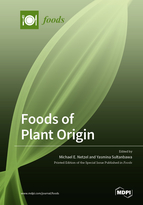Foods of Plant Origin
A special issue of Foods (ISSN 2304-8158). This special issue belongs to the section "Food Nutrition".
Deadline for manuscript submissions: closed (31 July 2019) | Viewed by 97466
Special Issue Editors
Interests: bioactive compounds; phytochemicals; plant food/material; food chemistry; nutritional biochemistry; in vitro models for digestion & bioaccessibility; in vivo bioavailability & metabolism
Interests: postharvest processing; storage; functional compounds; antioxidants; novel packaging; sensors; photodynamic treatments
Special Issues, Collections and Topics in MDPI journals
Special Issue Information
Dear Colleagues,
It is now well accepted that the consumption of plant-based foods is beneficial to human health.
Fruits, vegetables, grains and derived products can be excellent sources of minerals, vitamins and fibre and have usually a favourable ‘nutrient:energy ratio’. Furthermore, plant foods are also a rich source of phytochemicals such as polyphenols, carotenoids and betalains, with potential health benefits for humans.
Many epidemiological studies have made a direct link between the consumption of plant foods and health. Human intervention studies have also shown that higher intake/consumption of plant foods can reduce the incidence of the metabolic syndrome and other chronic diseases, especially in population at risk like obese people.
In addition to its health benefits, plant foods are also used as functional ingredients in food applications such as antioxidants, antimicrobials, natural colorants and improving sensory and textural properties.
Your proposed publication, which can address all aspects of “Foods of Plant Origin”, is welcomed to this Special Edition of Foods. The final deadline for submitting manuscripts is 30 June 2019. All manuscripts will be peer-reviewed, and manuscripts received before the deadline will be immediately processed.
Sincerely,
Dr. Michael Netzel
Assoc. Prof. Yasmina Sultanbawa
Guest Editors
Manuscript Submission Information
Manuscripts should be submitted online at www.mdpi.com by registering and logging in to this website. Once you are registered, click here to go to the submission form. Manuscripts can be submitted until the deadline. All submissions that pass pre-check are peer-reviewed. Accepted papers will be published continuously in the journal (as soon as accepted) and will be listed together on the special issue website. Research articles, review articles as well as short communications are invited. For planned papers, a title and short abstract (about 100 words) can be sent to the Editorial Office for announcement on this website.
Submitted manuscripts should not have been published previously, nor be under consideration for publication elsewhere (except conference proceedings papers). All manuscripts are thoroughly refereed through a single-blind peer-review process. A guide for authors and other relevant information for submission of manuscripts is available on the Instructions for Authors page. Foods is an international peer-reviewed open access semimonthly journal published by MDPI.
Please visit the Instructions for Authors page before submitting a manuscript. The Article Processing Charge (APC) for publication in this open access journal is 2900 CHF (Swiss Francs). Submitted papers should be well formatted and use good English. Authors may use MDPI's English editing service prior to publication or during author revisions.
Keywords
- Plant food
- Composition
- Nutrients
- Vitamins
- Phytochemicals
- Fiber
- Biofortification
- Processing
- Preservation
- Shelf-life
- Functional properties
- Products
- Bioaccessibility
- Bioavailability
- Health
- Humans








